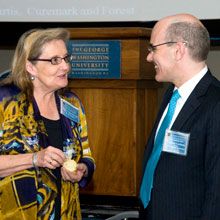
In late March, the Centers for Disease Control and Prevention released a report estimating that about one out of every 88 children was diagnosed with an autism spectrum disorder in 2008. That’s a more than 20 percent increase from 2006 and a spike that’s dominated recent headlines nationwide.
So it was fitting that the 2nd Annual Neuroscience Symposium at the George Washington University, hosted by the GW Institute for Neuroscience on May 2, was themed “Vision, Cognition, and Autism.” But it wasn’t intentional.
“Last September, when Sarah Shomstein and I were planning this symposium, we had no way of anticipating our choice would be as current and essential as it turned out to be,” said Anthony-S. LaMantia, Ph.D., professor in the Department of Pharmacology and Physiology at the George Washington University School of Medicine and Health Sciences (SMHS) and director of the GW Institute for Neuroscience (GWIN).
The recent report, he said, “actually identifies this problem and focuses many of the talks of the morning and the afternoon as a critical challenge for public health and environmental science.”
The symposium brought together over 60 researchers, psychologists, students, advocates, and others who wanted to learn about the latest advancements in vision, cognition, and autism-related neuroscience research.
“Recent advances range from the molecular level all the way to the behavioral level and have opened up windows that can start to provide some look into some very complex disorders that affect tens of millions of Americans, [and] hundreds of millions of people around the world,” said Vincent Chiappinelli, Ph.D., interim vice provost for Health Affairs and associate dean of SMHS, in his opening remarks.
Matt Colonesse, Ph.D., assistant professor in the Department of Pharmacology and Physiology in SMHS, kicked off the morning with a presentation about the development of central visual circuits. “One of the great questions of neuroscience is, how do you take a group of components and generate thought from it?” he said.
Collenesse’s research — most of which he conducted in Marseille, France, before joining the GW faculty — has pinpointed the moment that visual sensory input is actually comprehended in the brain. He also described some of the processes that lead up to the time of this “switch” and how they might go wrong in neural disorders.
“Thalamocortical network properties are very important and regulated piece of development and are potential targets for disease,” he said.
The morning’s keynote address was presented by John Maunsell, Ph.D., the Alice and Rodman Moorhead II Professor of Neurobiology at Harvard Medical School. In his presentation, “Neuronal Correlates of Visual Attention,” Maunsell described his work studying groups of neurons to better understand when and why attention shifts from moment to moment, and how it might be anticipated.
“The hope here is that by combining these many dozens of cells that we’ve recorded simultaneously, we can actually improve our measurement and get a reasonable estimate of how animals are allocating their attention,” he said.
Maunsell’s research has shown that this technique can predict large changes in people’s ability to perform difficult psychological tasks. However, because spatial and feature attention seem to be mostly independent of one another, his research suggests that people lack a strong centralized control — a finding he didn’t expect.
The afternoon session, chaired by Henry Kaminski, M.D., Ph.D., Meta Amalia Newmann Professor and Chair of the Department of SMHS's Department of Neurology, highlighted advances in autism and fragile X syndrome (FXS). Randi Hagerman, M.D., medical director of the MIND Institute at the University of California-Davis, delivered the day's second keynote address, which shed light on the latest research in FXS, and how those findings might pave the way for treatments in autism.
FXS is “the leading cause of inherited intellectual disability,” and is characterized by hyperactivity, impulsivity, anxiety, and mood instability, she said.
Although patients with FXS are heterogeneous — it affects all races and ethnicities — Hagerman, a developmental and behavioral pediatrician and a leader in the field of FSX research, emphasized the disease’s hereditary aspect. “When we evaluate patients with fragile x syndrome, we have realized it’s a family affair,” she said.
There are currently a range of treatments being used tested for FXS, including iPad-based interventions and drugs that influence the disease’s abnormally low levels of FMRP, an RNA-binding protein important for message transmission between neurons. Hagerman has also found antioxidants to be beneficial in the treatment FXS, because they “can normalize synaptic connections,” she said. “In fragile X, the synapses are immature and there’s too many of them.”
While Hagerman doubted the existence of a simple “cure-all” for FXS, she was hopeful that a cocktail of treatments will soon allow people with FXS — and perhaps eventually autism — to live highly productive, satisfying lives. She’s already seen drastic improvements in some of her patients. “Maybe we can cure this before I retire,” she said, “I would love that.”
The symposium also featured GW faculty members Sarah Shomstein, Ph.D., assistant professor Cognitive Neuroscience in the Department of Psychology in GW's Columbian College of Arts and Sciences; Jason Triplett, Ph.D., assistant professor of Pediatrics and of Pharmacology and Physiology at SMHS and investigator at the Center for Neuroscience Research (CNR) at Children's National Medical Center; and Molly Huntsman, Ph.D., assistant professor of Pediatrics and of Pharmacology and Physiology at SMHS and investigator at CNR. GW graduate students Chirsoper Gorini and Terawit Sarachana from the GW Institute for Biomedical Sciences; Jeongmi Lee from the Department of Psychology; and Kate Sokolowski, Ph.D., a post-doctoral fellow at CNR, also presented.
To them, Hagerman said, "It's an exciting time and a great time for all of you young guys to get into this exciting field."


